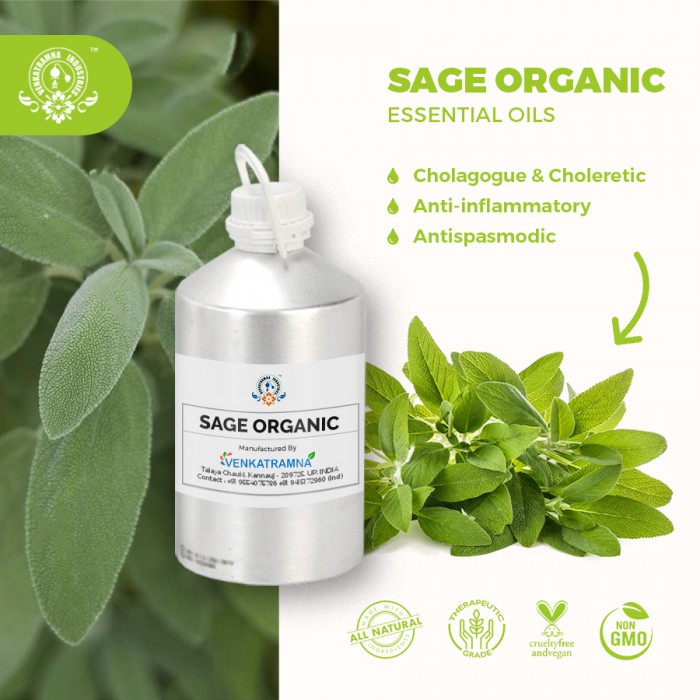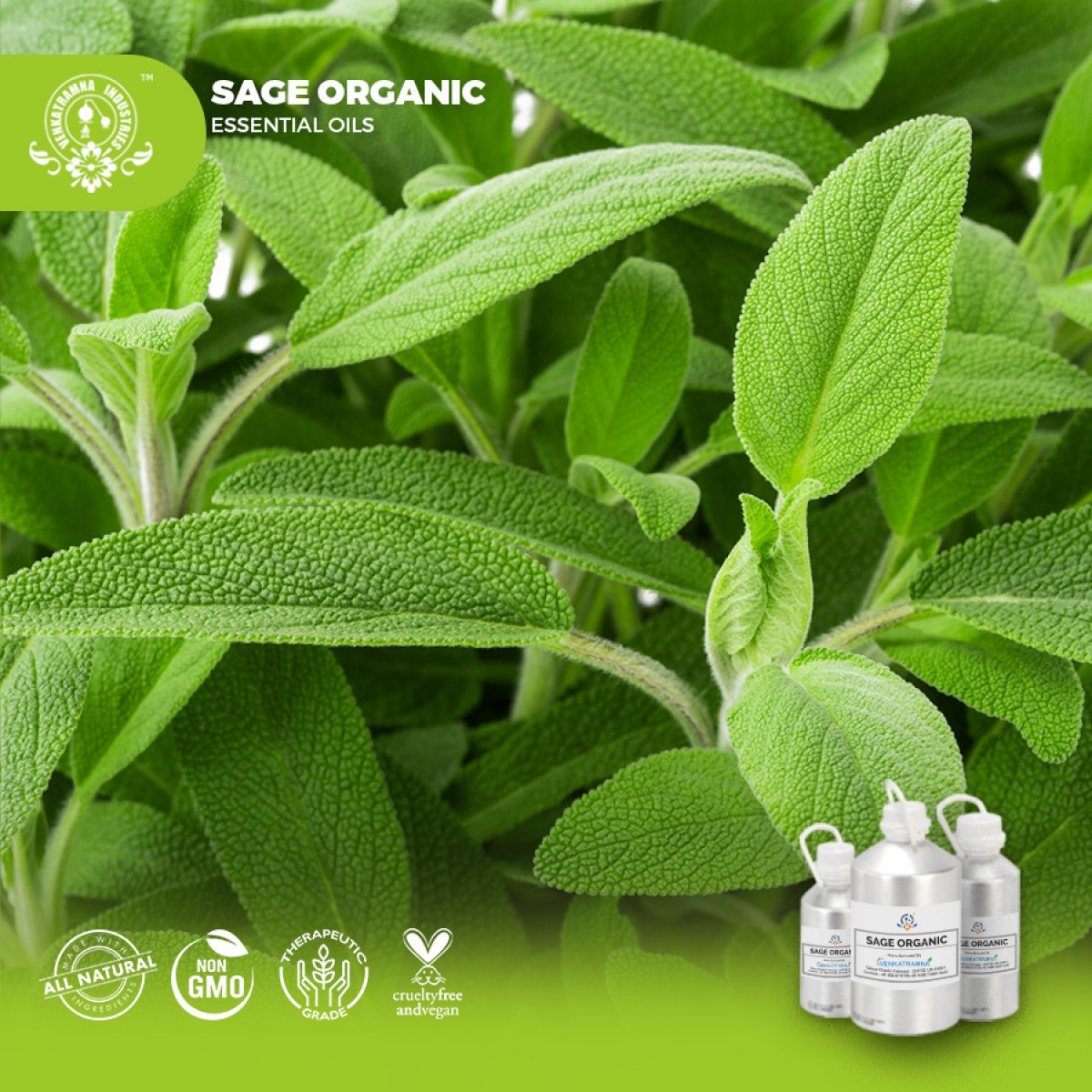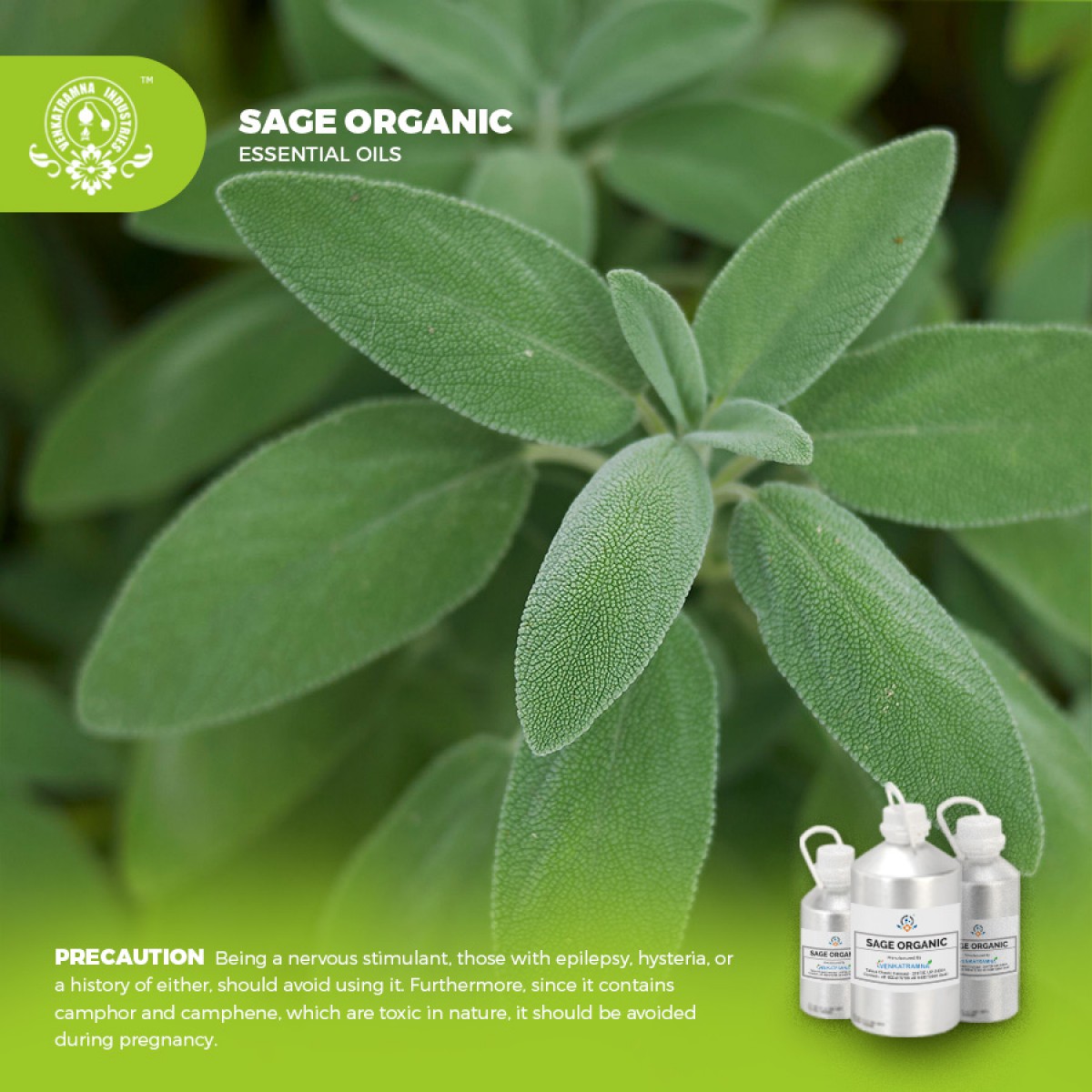Botanical Name: Salvia officinalis Common name: Sage, Plant fam Read More
|
Botanical Name: |
Salvia officinalis |
|
Common name: |
Sage, |
|
Plant
family: |
Lamiaceae |
|
Genus: |
Salvia |
|
Appearance/Color: |
A thin, clear, colourless to pale yellow liquid. |
|
Odor: |
A top note with a medium aroma, this oil has a warm and woody
scent, though sweeter and slightly floral. |
|
Blends With: |
Orange, Bergamot, Neroli, LIme, Lemon, Grapefruit,
Lavender, Jasmine and Rose. |
|
Origin: |
Spain |
|
Source: |
Leaves |
|
Method
of Extraction: |
Steam Distillation |
Salvia officinalis commonly
called sage, is the culinary sage familiar to most cooks. It also has excellent
ornamental qualities, however. Variably called culinary sage, common sage or
garden sage, this woody-stemmed, semi-shrubby perennial typically grows 1.5-2.5'
tall.
S. officinalis (sage, garden sage, or common sage) is a perennial, evergreen subshrub, with woody stems, grayish leaves, and blue to purplish flowers. It is native to the Mediterranean region, being currently cultivated in various countries. Sage is one of the oldest medicinal plants, and the etymology of the Latin name suggests its healing properties, with Salvia deriving from the Latin verb salvare = to save or to cure, and officinalis also means medicinal.
DISCLAIMER
The complete range of conditions
or methods of use are beyond our control therefore we do not assume any
responsibility and expressly disclaim any liability for any use of this
product. Information contained herein is believed to be true and accurate however,
all statements or suggestions are made without warranty, expressed or implied,
regarding accuracy of the information, the hazards connected with the use of
the material or the results to be obtained from the use thereof. Compliance
with all applicable federal, state, and local laws and local regulations
remains the responsibility of the user.
The FDA has not evaluated the
statements on this website. No claims are made by Venkatramna Industries as to
the medicinal value of any products from vriaroma.com or by us. The information
presented here is for educating our customers about the traditional uses of
essential oils and is not intended to diagnose, treat, cure, or prevent any
disease. You are responsible for understanding the safe application of these products.
If you have any questions, please call or email us for further information.
As per NAHA guidelines, New Directions Aromatics (NDA) does not recommend the ingestion of essential oils. It is imperative to consult a medical practitioner before using Essential Oils for therapeutic purposes. Pregnant and nursing women and those taking prescription drugs are especially advised not to use this product without the medical advice of a physician. The oil should always be stored in an area that is inaccessible to children, especially those under the age of 7.
Salvia sp. has also been used for a long time in folk medicine as
medication against fever, rheumatism, perspiration, sexual debility, and in the
treatment of chronic bronchitis, as well as mental and nervous diseases. Salvia officinalis L. (Lamiaceae) is a
Mediterranean species, naturalized in many countries. In Jordan, it is used in
traditional medicine as antiseptic, antiscabies, antisyphilitic, and
anti-inflammatory, being frequently used against skin diseases.
Common sage is well known in Palestitian traditional medicine
by possessing antimicrobial properties. Essential oil of sage and their
preparations are externally used for inflammations and infections of the mucous
membranes of throat and mouth (stomatitis, gingivitis, and pharyngitis).
Internally, the essential oil is used for dyspeptic symptoms and excessive
perspiration.
Sage is largely used as a savory food flavoring either as
dried leaves or essential oil. Sage leaves and its essential oil possess
carminative, antispasmodic, antiseptic, astringent, and antihidrotic
properties. The predominant medicinally valuable metabolites are monoterpenes
(e.g., ?- and ?-thujone, 1,8-cineole, camphor), diterpenes (e.g.,
carnosic acid) triterpenes (oleanoic and ursolic acids), and phenolic compounds
like rosmarinic acid.
COMMON
USAGE
·
Antifungal
·
Antimicrobial
·
Antibacterial
·
Antioxidant
·
Antiseptic
·
Anti-inflammatory
·
Antispasmodic
·
Cholagogue and choleretic
·
Cicatrisant
·
Depurative
·
Digestive
·
Disinfectant
·
Emmenagogue
·
Expectorant
·
Laxative
·
Stimulant
Ingredients:
|
S.No |
Key Constituents |
Strength (%) |
|
1 |
Camphor |
7.3-50.2 |
|
2 |
a-thujone |
13.1-48.5 |
|
3 |
borneol |
1.5-23.9 |
|
4 |
1,8-cineole |
1.8-21.7 |
|
5 |
b-thujone |
3.9-19.1 |
|
6 |
b-caryophyllene |
0.2-9.7 |
|
7 |
camphene |
0-8.6 |
|
8 |
a-pinene |
0-8.0 |
|
9 |
Bornyl acetate |
0.3-5.7 |
|
10 |
b-pinene |
0-1.2 |
Safety Summary
·
Hazards May be neurotoxic, based on camphor
content
·
Contraindications Should not be taken in
oral doses.
·
Contraindications (all routes) Pregnancy,
breastfeeding.
·
Maximum dermal use level 0.4%
Organ Specific Effects
·
Adverse skin reactions: Undiluted
Dalmatian sage oil was moderately irritating to rabbits; tested at 8% on 25
volunteers it was neither irritating nor sensitizing. A 24-hour patch test
using undiluted sage oil produced one irritation reaction in 20 volunteers. A
65-year-old aromatherapist with multiple essential oil sensitivities reacted to
both 1% and 5% sage oil.
·
Cardiovascular effects: A subcutaneous
injection of 39 mg/kg of sage oil caused hypoglycemia in both normal and
alloxan-diabetic rats after one hour. In contrast, Eidi et al found no
significant change in serum glucose levels in streptozotocin-diabetic rats for
up to five hours after ip administration of 0.042, 0.125, 0.2 or 0.4 mL/kg of
Dalmatian sage oil.
·
Reproductive toxicity: When Dalmatian
sage oil (0.25%, 375 mg/kg) was fed to pregnant mice for two weeks, it
negatively influenced the distribution of embryos according to nucleus number.
·
Neurotoxicity Convulsions appeared for
sage oil at over 500 mg/kg ip in rats. A 44-year-old woman who weighed 133 lb
died hours after ingesting two easpoons of sage oil as a treatment for asthma
Before dying she suffered epileptiform convulsions. Doctors reported cardiac
failure and dyspnea, and estimated that she had drunk 0.25 oz. Post-mortem
examination showed only slight damage to the stomach and small intestine. The
lungs smelled strongly of sage, and were ‘emphysematous’. No other organ showed
any sign of damage. In a second case, convulsions occurred in an adult who
accidentally ingested one ‘swallow’ of sage oil. In a third case, a 54-year-old
woman ingested at least one ‘swallow’ of sage oil. After 30 minutes she
suffered a tonic-clonic seizure and remained unconscious for one hour. In a
fourth case, a 53- year-old man ingested 12 drops of sage oil. He rapidly
developed a tonic-clonic seizure followed by a 15 minute coma. Neurological
tests were normal. In three further non-fatal cases, all in Turkey, accidental
ingestion of sage oil by a newborn, a 1-month-old boy and a 5 1/2-year-old girl
was followed by seizures.
·
Hepatotoxicity An essential oil of Salvia
officinalis with 17.4% a-thujone, 13.3% a-caryophyllene, 12.7% 1,8-cineole,
8.3% borneol 3.9% b-thujone, 3.3% camphor was tested for toxicity to rat
hepatocytes. The oil was not toxic when present at concentrations of 200 nL/mL
or less. However at 2,000 nL/mL significant LDH leakage and glutathione
decrease occurred, indicating cell damage.
Systemic Effects
·
Acute toxicity: Dalmatian sage oil acute
oral LD50 in rats reported as 2.6 g/kg both by Opdyke and Von Skramlik acute
subcutaneous LD50 in mice 1.95 g/kg acute dermal LD50 in rabbits >5 g/kg.
·
Antioxidant/ pro-oxidant activity : Dalmatian
sage oil showed high antioxidant activity as a DPPH radical scavenger and
against lipid peroxidation.
·
Carcinogenic/anticarcinogenic potential: Dalmatian
sage oil was not mutagenic in a chromosomal aberration test, a Bacillus
subtilis rec-assay or the Ames test. It was similarly non-mutagenic in S.
typhimurium strains T98 and T100, with or without S9. Sage oil was not
mutagenic in S. typhimurium TA100, and inhibited UV-induced mutations.
Dalmatian sage oil was antimutagenic in Salmonella/microsome, E. coli K12, and
S. cerevisiae D7 reversion assays. Given orally to mice at 25, 50 or 100 mL/kg,
Dalmatian sage oil was not mutagenic at the low dose, but was slightly
mutagenic at 50 mL/kg. At 100 mL/kg the oil was cytotoxic. Both of the lower
doses inhibited CA induced by mitomycin C. Dalmatian sage oil was active
against human melanoma and renal cell adenocarcinoma cell lines in vitro. It
was cytotoxic to human oral squamous cell carcinoma cells, with an IC50 of 135
mg/mL.
·
Serious eye damage / irritation No
additional Data available.
·
Respiratory or skin sensitization No
additional data available.
·
Germ Cell Mutagenicity No additional data
available.
·
Reproductive toxicity No additional data
available.
·
STOT-single exposure No additional data
available.
·
STOT-repeated exposure No additional data
available.
·
Aspiration hazard: No additional data
available.
·
Photo-toxicity: No additional data available.
·
Ecotoxicity: Toxic to aquatic life with long
lasting effects. The product must not be allowed to run into drains or
waterways.
·
Bioaccumulation: No data available
·
Mobility in soil: No data available
·
Persistence and degradability: No data available
·
PBT and vPvB assessment: No data available
Avoid direct
exposure into water streams and ground water sources.





 MSDS-Sage.pdf
MSDS-Sage.pdf




